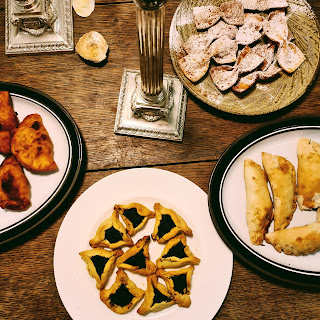Purim pies
Wow, it's been a while since I wrote a proper blog post. There are half a dozen in draft but it's been busy, what can I say. Plus it feels flippant to write about food or planning policy or public projects here when the world is so full of sadness and horror.
But I started this little project and I want to keep a record of what and how and when. If you want a little glimpse of a couple of festive meals - from the Deep South and from Japan - that we made in the last couple of weeks, have a look at my instagram. Today I thought I would jot down a few longer notes about today's #cookingtheyear festive foods, which draw on the work of Claudia Roden and start our exploration of Jewish holiday foods - of which there will be many more over the coming weeks.
Today is Purim - a Jewish holiday which - as I have been reading - has a lot to do with food, particular sweets and pastries. When my daughter mentioned it to a friend of hers who is of Jewish heritage, he described it as the Jewish Halloween, and there is also traditionally dressing up and drinking involved. It celebrates a complicated story that boils down to the cunning of Esther in delivering the Babylonian Jews from a pogrom, and the baddie in the story is a courtier named Haman, who has lent his name to the most common foods associated with Purim as a festival. Our family will probably now call Purim the pie-day, as it's a long time since quite so many varieties of pastry have been seen on one table.
Hamantaschen - Haman's hats - are little three-cornered pastries filled with a poppyseed filling, supposedly recollecting the hat's of the 'odious Haman', as Roden describes him, and come from the Ashkenazi tradition. From the Sephardi side we made Orecchie di Haman - Haman's ears, deep-fried bowties of pasta dough sprinkled with sugar and cinnamon. And we started off with chickpea-stuffed sambousak - a sort of Arab / Iraqi pasty - in both deep-fried and baked versions. (Purim is a dairy-vegetarian holiday due to Esther apparently being on a vegetarian diet when in the palace of the Persian king.)
Many have Roden's Book of Jewish Food on their shelves, but I'm going to hazard a guess that not many actually cook from it. It is both a work of fantastic scholarship and also very personal, filled with stories from her family, friends and correspondents from the Jewish diaspora across the world, but unlike the bestselling cookbooks (many of whom credit Roden heavily for their inspiration) it has hundreds of recipes but no photos of of the finished dishes, and the instructions - drawn often from historical sources or scraps of paper jotted down - can be laconic. It's therefore a rather different challenge to cook from it when these dishes are outside of one's own family or cultural experience - you have to make a fair few decisions about how something is meant to look or taste.
While I spent a fair amount of time in Israel and the West Bank many years ago (you can read a little here) and celebrated some of the other festivals with Jewish friends, these recipes were unfamiliar to me so I tried to follow the recipe instructions faithfully but this certainly was not without pitfalls. The sweetened pastry for the hamantaschen was definitely tricky to handle and half our three-cornered hats unfolded during baking. I could have also done a better job on the filling, although in my defence there was some confusion in the recipe which had just one lot of butter in the ingredients list, but two steps in the process which involved adding butter. But they certainly were tasty when completed, if not the neat triangles of photos I looked up online afterwards. I think we should have gone even thinner on the pasta maker for the orecchie - I went down to the second-to-last setting but should have been braver. Still, everyone loved the fried pasta - but who wouldn't like deep fried pastry covered in sugar!

But the undoubted hit of the evening was the sambousak. A soft dough filled with a spiced chickpea and onion mix, they puffed up beautifully when deep-fried and were incredibly moreish. Roden says she prefers the baked version but without a doubt the tasting panel here at home preferred the fried - which also have the added bonus of cooking very quickly. (Though the baked were also liked and one panel member - not myself! - managed to eat 6 across both varieties.) Roden has a whole chapter on similar savoury pies and I can see us now working enthusiastically through all of them. (the photo below makes them look rather burnt, but that's my poor photography...they were nicely browned, promise!). The name and the nature of these made me wonder if there's a link to Indian samosas. * Note from my improved reading on Indian food - yes, sambousak and samosas are the same in origin.*
I'm not going to draw any facile comparison between the deliverance of Jews from persecution in ancient Persia, the Jewish history in Ukraine or the present war. We - do we really need to state it? - stand fully with Ukraine and with all those who are suffering and losing their lives due to unjust wars across the world. I've heard a lot from artists and musicians over the last few weeks about how art and music stand for peace, for comfort, for freedom. Roden's book talks of food as cultural exchange, as generosity and as simple comfort too. I hope you don't mind me writing about it as a little pleasure in our household and a way to learn and explore the world from our dining table.


Comments